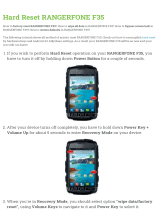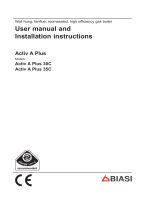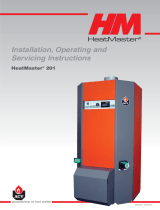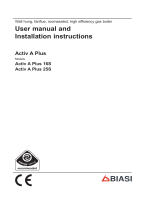Page is loading ...

delta
performance
delta performance
F25 / F35 / F45
Installation , Operating &
Servicing Instructions

1.1 PEOPLE WHO SHOULD READ THESE
INSTRUCTIONS
These instructions should be read by: - the specifying engineer
- the installation engineer
- the user
- servicing technicians
1.2 SYMBOLS
The following symbols are used in these instructions:
Essential to ensure that the system works
properly.
Essential for personal safety and
environmental protection.
Danger of electrocution.
Danger of burns.
1.3 APPLICABLE STANDARDS
The products have been granted the “EC” certificate in accordance
with the standards in force in different countries (European Directives,
92/42/EEC “efficiency” and 90/396/ECC “gas devices”). These
products have also been granted the Belgian “HR+”(gas boilers) and
“OPTIMAZ” (oil boilers) marks.
1INTRODUCTION 2
1.1 People who should read these instructions 2
1.2 Symbols 2
1.3 Applicable standards 2
1.4 Warnings 2
2INSTALLATION 3
2.1 Boiler room 3
2.2 Connections 3
2.4 Electrical connections 6
3STARTING UP 7
3.1 Filling the heating and domestic hot water circuits 7
3.2 Troubleshooting the burner 7
4SERVICING 7
4.1 Recommendation 7
4.3 Servicing the oil boiler 7
4.4 Servicing the safety devices 7
4.4 Servicing the burner 8
4.6 Emptying the boiler 8
4.7 Spare parts 8
5DESCRIPTION 9
5.1 Overview 9
5.2 Description of operation 9
5.3 Build features 10
6TECHNICAL SPECIFICATIONS 11
6.1 Effective dimensions 11
6.2 Maximum operating conditions 11
6.3 Domestic hot water performance 11
6.4 Boiler without burner 11
7USER GUIDE 14
7.1 Using the boiler 14
7.2 Boiler room 15
INDEX 1 INTRODUCTION
2
1.4 WARNINGS
These instructions are an integral part of the equipment to which they
refer and the user must be provided with a copy.
The product must be installed and serviced by qualified engineers, in
compliance with current standards.
ES cannot accept liability for any damage resulting from incorrect
installation or from the use of components or fittings not specified by ES.
Any failure to follow instructions relating to tests and
test procedures may result in personal injury or risks of
pollution.
Because of their high level of performance our boilers
produce flue gas discharge at low temperatures. This
can cause condensation in some chimney flues. Your
installing engineer will advise you whether you need to
install a flue pipe in your chimney.
N.B.
ES reserves the right to change the technical specifications and
components of its products without prior notice.

2.1 BOILER ROOM
2.1.1 ACCESSIBILITY
The boiler room must be large enough to allow proper access to the
boiler. The following minimum distances (mm) around the boiler are
required:
- at the front 500 - at the sides 100
- at the rear 150 - above 700
2.1.2 VENTILATION
The boiler room must be fitted with top and bottom vents as shown in
the table below.
2.1.3 BASE
The boiler must be laid on a base made of non-combustible materials.
2.2 CONNECTIONS
2.2.1 CHIMNEY CONNECTION
The boiler can be connected to a suitable flue or to chimney by a metal
pipe rising at an angle from the boiler to the chimney. It must be easily
removable in order to give access to the flue pipes when servicing the
boiler. A draught regulator must be installed on the chimney in order to
stabilise negative pressure.
Because of their high level of performance our boilers
produce flue gas discharge at low temperatures. This
can cause condensation in some chimney flues. Your
installing engineer will advise you whether you need to
install a flue pipe in your chimney.
Important
Boilers must be installed by an approved engineer, in
accordance with current local standards and regulations.
2.2.2 CENTRAL HEATING CONNECTION
2.2.2.1 Examples of basic circuit configurations
The drain cock and safety valve must be connected to the waste
water disposal system.
Fig. 2: Hydraulic diagram showing circulator controlled
by a room thermostat.
2 INSTALLATION
6
2
3
47
5
99
10
Fig. 1: Boiler room ventilation and chimney connection
A
B
F
D
C
E
A. Top vent
B. Bottom vent
C. Draught regulator
D. Inspection cover
E. Chimney height
F. Chimney diameter
3
Ventilation F25 F35 F45
Min. fresh air
requirement m3/h 50/66 66/90 84/122 100/138 45 63 81 99
Top vent (A) dm22 2 2 2 1,5 1,5 1,5 1,5
Bottom vent (B) dm21,5 1,5 1,5 1,5/2,1 1,5 1,5 1,5 1,7
Chimney
E = 5m Ø min.F mm 158/182 182/213 208/248 226/266 160 189 215 236
E = 10m Ø min.F mm 133/153 153/179 175/209 190/223 135 159 181 199
E = 15m Ø min.F mm 130/138 138/162 158/188 172/202 130 143 163 179

2.2.2.2 ES hydraulic kit
ES offers an optional pre-assembled hydraulic kit comprising:
- A circulator.
- A motorised 3-way manual valve.
- Connecting pipes including an optional second circuit.
- Two isolation valves.
- Connectors for mounting the safety valve with pressure gauge
and the filling valve to the right or left of the expansion tank.
2.2.2.3 Discharge
The drain cock and safety valve must be connected to the waste
water system in accordance with current regulations.
2.2.3 DOMESTIC HOT WATER CONNECTION
2.2.3.1 Pressure reducer
If the water mains pressure is greater than 6 bar, a pressure
reducer calibrated to 4.5 bar must be fitted.
2.2.3.2 Safety unit
The tank safety unit must be ES approved and calibrated to 7
bar.The valve discharge must be connected to the waste water
system in accordance with current regulations.
2.2.3.3 Domestic hot water expansion tank
Installing a hot water expansion tank avoids any risk of pressure
surges due to waterhammer.
2.2.3.4 Hot water circulation
If the tank is located a long way from the point of use, then
installing a closed recirculation circuit ensures that a faster supply
of hot water is always available.
2.2.3.5 Description
1. Safety unit
2. Pressure reducer
3. Thermostatic mixing valve
4. Hot water circulator
5. Non-return valve
6. Domestic hot water type expansion tank
7. Inlet valve
8. Draw-off valve
9. Bleed valve
IMPORTANT
As a safety measure against burns, we strongly advise
installing a thermostatic mixing valve (recommended
temperature: 60° C).
This is available as an optional accessory
2INSTALLATION
Fig. 4: Assembly with the ES hydraulic kit
Fig. 5a: Connection without thermostatic mixing valve
1
2
4
6
5
7
9
8
1
2
3
4
6
5
7
9
8
Fig. 5b: Connection with thermostatic mixing valve
4
Safty unit Ø 3/4”
Pressure reducer Ø 3/4”
Thermostatic mixing valve Ø 3/4”
Expansion tank 5 litres

2 INSTALLATION
6
2.4 ELECTRICAL CONNECTION
2.4.1 DESCRIPTION OF POWER SUPPLY
The boiler operates on single phase 230 V – 50 Hz. An on-off switch
box with 6 A fuses must be fitted outside the boiler to allow power to
be shut off during servicing and before any repairs are carried out on
the boiler.
2.4.2 COMPLIANCE
Boiler installation must comply with current local standards and
legislation.
2.4.3 SAFETY
The stainless steel tank must be earthed separately.
2.4.4 BURNER ELECTRICAL CONNECTION
The burner is powered through a 3-core cable, which is plugged into
the connector in the lower right hand corner of the burner chamber
plate. Details of how to connect it up aregiven in the technical
instructions for the burner.
Fig. 9 Control panel
It is important to switch the boiler off before carrying out
any work.
2 41 3 5
1. Boiler thermostat (60/90° C)
2. On/off switch
3. Summer/Winter selector switch
4. Thermometer
5. Controller (optional)
6. Safety thermostat (95° C max.)
7. Safety thermostat (103° C max.)
8. Plug for power and control
9. Central heating circulator connection
10. Burner connection
11. Room thermostat
M. Brown
O. Orange
N. Black
B. Blue
T. Green-yellow
G. Grey
J. Yellow
Fig. 10 a: Boiler wiring
1
2
C
L1
L1
N
T1
T
2
N
T1
T2
S3
S3
7
6
2
1
3
2
30
V-
50
Hz
6A
9
M
B
O
B
N
O
B
B
O
N
T
11
S3
B4
N
T1
T2
L1
M
M
8
1
0

3.1 FILLING THE HEATING AND DOMESTIC
HOT WATER CIRCUITS
1. Fill the domestic hot water circuit and bring it up to pressure.
IMPORTANT
The hot water tank must be pressurised before the
heating circuit is filled.
2. Fill the heating circuit taking care not to exceed the 2 bar
pressure limit.
3. Bleed the air from the top of the boiler.
4. After bleeding the air out of the system, bring the pressure up to the
static pressure (height) plus 0.5 bar: 1.5 bar = 10 m – 2 bar = 15 m.
5. Check the power connection, the boiler room ventilation and ensure
that there are no leaks in the flue gas discharge pipes.
6. Set the thermostat (1) to between 60 and 90° C.
3 STARTING UP 4 SERVICING
Fig. 11: Control panel
7. Set the Summer/Winter selector switch (3) to the desired position.
8. Switch the on/off switch (2) to the ON position.
9. Check the pressure of the gas supply when starting up.
10. For the oil burner check the oil supply (and return).
Carry out any bleeding, measuring and adjustment work which
may be necessary.
3.2 TROUBLESHOOTING THE BURNER
3.2.2 OIL BURNER
Please refer to the servicing and troubleshooting instructions for the
burner.
Before carrying out any servicing or repair work, switch
the power off at the mains switch fitted in the boiler room
by the electrician.
21 3
4.1 RECOMMENDATION
ES recommend that boilers should be serviced at least once a year.
The burner must be serviced and tested by a competent engineer.
4.2 SERVICING THE BOILER
1 - Switch the power off at the mains switch outside the boiler and
close the oil tap.
2 - Set the on/off switch on the control panel to the OFF position.
3 - Release and remove the chimney flue (1) to free the top of the
boiler.
4 - Remove the jacket top (2) and lift off the flue reducer (3).
5 - Remove the baffles (4) from the flue pipes (5) for cleaning.
Replace them if they are in poor condition.
6 - Remove the chamber plate (6).
7 - Brush the flue pipes (5).
8 - Clean the burner chamber (7) and the burner (8).
9 - Check the insulation on the chamber plate (6)
1. Chimney flue
2. Jacket cover
3. Chimney flue reducer
4. Baffles
5. Flue pipes
6. Chamber plate
7. Combustion chamber
8. Burner
Fig. 12: Description of the main components
which require servicing.
4.3 SERVICING THE OIL BOILER
- Switch the power off at the mains switch outside the boiler and
close the oil inlet.
4.4 SERVICING THE SAFETY DEVICES
- Check that all thermostats and safety devices are working properly:
boiler thermostat, cut-off thermostat and manually reset safety
thermostat.
- Check the safety valves on both the central heating and the hot
water circuits.
7
3
2
5
4
7
1
6
8

4.5 SERVICING THE BURNER
4.5.1 OIL BURNER
- Check the main filter on the oil line and clean it if necessary.
- Check the nozzle line: check, clean or change the nozzle and filter,
check that it is clean and that the electrodes and flame holder are
properly set.
- Replace the whole unit and check that the safety devices are
working properly
- Adjust the combustion parameters.
4.6 EMPTYING THE BOILER
4.6.1 EMPTYING THE PRIMARY CIRCUIT (CENTRAL HEATING):
1. Switch the power to the boiler off at the mains switch installed by
the electrician.
2. Close the boiler system’s isolating valves (1).
3. Connect a hose to the drain cock (2).
Make sure that it is properly attached.
4. Open the drain cock and let the hot water drain out.
5. When the boiler is empty, return the valves to their initial positions
4.6.2 EMPTYING THE DOMESTIC HOT WATER TANK:
1. Switch the mains power to the boiler off at the external switch
installed by the electrician.
2. Remove the pressure from the primary circuit.
3. Close valves (A) and (B).
4. Open valves (C) and (D) (first C then D).
5. Let the water drain away.
6. After emptying, return the valves to their initial positions.
To allow the tank to be emptied, valve (C) must be
situated at ground level.
4.7 SPARE PARTS
Please refer to the specific document available from ES or your
distributor.
4 SERVICING
Fig. 13a: Emptying the primary circuit
Fig. 13b: Emptying the hot water circuit
11
2
A
C
B
D
8

5.1 OVERVIEW
• Combination boiler (central heating and domestic hot water).
• Designed for connection to a chimney.
• TANK-IN-TANK indirect storage type domestic hot water production.
• Fittings required to connect the hydraulic kit for feeding the heating
circuit (available as an optional extra).
• Control panel with on/off switch, adjustable thermostat,
thermometer, Summer/Winter selector and knockout for fitting
integrated control system (optional).
• DELTA Performance F25, F35 and F45 models - with effective
outputs adjustable between 22 and 54 kW - are shipped with an
5.2 DESCRIPTION OF OPERATION
5.2.1 THE TANK-IN-TANK CONCEPT
The DELTA Performance series differs from traditional hot water
producers in that it has a ring-shaped tank immersed in the primary
fluid contained in the outer body. When hot water from the central
heating system or the domestic hot water system is needed, the
thermostat starts up the burner. The combustion gases quickly heat up
the primary fluid, thus creating a natural circulation around the tank.
5.2.2 INDIRECTLY HEATING DOMESTIC HOT WATER
This circulation allows easier heat exchange between the primary fluid
and the domestic water, all over the tank surface. The corrugations on
the inner and outer shells of the ring-shaped tank increase the area of
heat exchange still further and thus speed up the process of heating
the domestic water.
5.2.3 EASY TO SET AND SAFETY ASSURED
With a single command, the water temperature of both the primary
circuit and the domestic hot water circuit can be set by the adjustable
thermostat situated underneath the tank in the primary circuit.
A cut-off thermostat, placed on the top of the boiler automatically
switches off the burner when the temperature of the water in the
primary circuit reaches 95° C. A manually reset safety thermostat
switches off the burner if the temperature reaches 103° C.
5 DESCRIPTION
1. Primary fluid
2. Domestic hot water
3. Combustion chamber
Fig. 14: Stainless steel domestic hot water tank
1
2
5
3
4
4
Fig. 15: Brief description of the boiler
9
4. Control thermostat
5. Burner

5.3 BUILD FEATURES
5.3.1 OUTER BODY
The outer body containing the primary fluid is made of STW 22 steel.
5.3.2 TANK-IN-TANK TYPE EXCHANGER ACCUMULATOR
The ring-shaped inner tank with its large heating surface, used for
producing domestic hot water, is built using Chrome/Nickel 18/10
stainless steel. It is corrugated all the way up to the top using an
exclusive production process and entirely argon arc welded using the
TIG (Tungsten Inert Gas) method.
5.3.3 COMBUSTION GAS CIRCUIT
The combustion gas circuit is protected by a coat of paint. The
combustion gas circuit comprises:
5.3.3.1 Flue pipes
Depending on output, the various DELTA Performance models
contain either 4 or 8 steel flue pipes with an inner diameter of 64
mm. Each pipe is fitted with a special steel baffle designed to
improve heat exchange and reduce the flue gas temperature.
5.3.3.2 Combustion chamber
All DELTA Performance models feature a fully water-cooled
combustion chamber.
5.3.4 INSULATION
The boiler body is fully insulated by rigid polyurethane foam with a high
thermal insulation coefficient. This is sprayed onto the tank without
using any CFCs.
5.3.5 JACKET
The boiler is covered by a steel jacket which has been scoured and
phosphated before being stove finished at 220° C.
IMPORTANT
For assembly, the various settings, start-up and servicing
please see the technical instructions which come with
the burner.
5.3.7 CONTROL PANEL (FIG. 17)
1 - Thermostat adjustable between 60° and 90° C
2 - On/off switch
3 - Summer/Winter selector switch
4 - Thermometer
5 - Knockout for control system (optional).
1. Inner ring-shaped tank containing the domestic hot water
2. External body containing central heating circuit
3. Insulation
4. Jacket
5. Flue pipes
6. Baffles
7. Thermostat adjustable between 60° and 90° C
8. Lower central heating return
9. Combustion chamber
10. Chamber plate
11. Emptying the boiler
12. Upper central heating flow pipe and return
13. Chimney connection
14. Control panel
15. Domestic hot water outlet
16. Domestic cold water inlet
17. Cut-off thermostat 95° C / Thermometer
18. Manually reset 103° C safety thermostat
19. Oil burner
5 DESCRIPTION
Fig. 16: The boiler
12
1
15
2
4
3
5
14
6
8
11
9
13
7
16
18
7
10
19
17
Fig. 17: Control panel
2 41 3 5
10

6.1 EFFECTIVE DIMENSIONS
Units are shipped fully assembled, tested and packed on a timber base
with shockproof edges and protected by a heat-shrunk plastic film.
On reception and after unpacking, check the equipment for any damage.
For transportation purposes, please see the weights and dimensions
given below:
6.2 MAXIMUM OPERATING CONDITIONS
Maximum operating pressure (tank full of water)
- Primary circuit: 3 bar
- Secondary circuit: 10 bar
Test pressure (tank full of water)
- Primary circuit: 4.5 bar
- Secondary circuit: 13 bar
Operating temperature
- Maximum temperature: 90° C
6 TECHNICAL SPECIFICATIONS
570 B
D542
200
C
061
851811
A
Fig. 18: Effective dimensions
6.3 DOMESTIC HOT WATER PERFORMANCE
6.4 BOILERS WITHOUT BURNER
11
Dimensions
F25 F35 F45
A
1497 1697 1497
B
130 130 150
C
360 360 390
D
818 818 818
Kg
157 168 180
Domestic hot water performance F25 F35 F45
OPERATING AT 80° C
Peak flow at 40° C (∆T = 30° C) l/10’ 268 285 316
Peak flow at 40° C (∆T = 30° C) l/60’ 806 1035 1284
Continuous flow 40° C (∆T = 30° C) l/h 645 900 1161
OPERATING AT 80° C
Start-up minutes 32 29 16
After drawing off 140 l at 45° C minutes 15 11 9
25 35 45
Heat release rate (input) kW 25/33 33/45 42/61
Effective rated output (output) kW 22/29 29/40 38/54
Maintenance loss at 60°C as % of rated value %1,36/1 1/0,79 0,8/0,56
Total capacity l157 178 132
Primary circuit capacity l83 104 70
Central heating connection Ø1” 1” 1”
Domestic hot water connection Ø3/4” 3/4” 3/4”
Hot water tank heat exchange surface m21,59 1,59 1,99
Weight when empty Kg 145 156 168

7.1 USING THE BOILER
7.1.1 LEARNING YOUR WAY AROUND THE
CONTROL PANEL (FIG. 23)
Before carrying out any work on the boiler, switch the
power off at the mains switch installed in the boiler room
by the electrician.
Turn the ON/OFF switch on the control panel off.
(item marked 2, Fig. 23)
1 - Thermostat adjustable between 60 and 90° C (item marked 1, Fig. 23)
Central heating systems are generally designed to operate at
amaximum of 80° C. When used at lower temperatures, a 3-way mixer
valve installed on the heating flow pipe (see Fig. 3 on page 3) allows the
temperature to be set manually or, if you decide to install a regulator (§
2.2.4), automatically.
We recommend that you set the thermostat to the maximum values to
get the best out of the domestic hot water system.
There is a risk of burns from hot water!
The water stored in the domestic hot water tank in the boiler can be at
a very high temperature.
In all cases, install the thermostatic mixer (Fig. 5b on page 4) on the
domestic hot water flow pipe which must not exceed 60° C. A mixer or
mixing valve at each point of use is recommended.
2 - ON/OFF switch (item marked 2, Fig. 23)
This must be used to switch the boiler off before carrying out any work
on it.
3 - Summer/Winter selector switch (item marked 3, Fig. 23)
“Winter” position: provides both domestic hot water and central heating
functions. “Summer” position: The room thermostat or regulator (§ 2.2.4)
is switched off. The central heating circulator is also switched off. Only
the domestic hot water function is provided. You can use the thermostat
(1) to reduce the temperature and save energy. If there is not enough
hot water available, we recommend setting the thermostat (1) to its
maximum value.
When the weather turns cold again, simply select “Winter” to reactivate
the heating system.
4 - Thermometer (item marked 4, Fig. 23)
Reads the boiler primary circuit (central heating) temperature directly.
5 - Controller (item marked 5, Fig. 23)
Please refer to the enclosed instructions if you have chosen this option.
7.1.2 CENTRAL HEATING SYSTEM GAUGE PRESSURE
Your system is fitted with a central heating safety valve, set to 3 bar,
which is fitted with a pressure gauge.
First make sure that the water in the system is still pressurised. When
cold and after the air in the system has been bled, the pressure gauge
should show a pressure of between 1 and 2, depending on the height
of the building: (1 bar = 5m / 1.5 bar = 10 m and 2 bar = 15 m).
To add water, open the filling valve (Fig. 2 and 3 on page 3). Make sure
the valve is properly closed after filling. Bleed the air in the system to
get an accurate water pressure reading.
7.1.3 SAFETY VALVE (central heating)
(item marked 2, Fig. 3 on page 3)
The water, which may flow out of the safety valve
is very hot and may cause serious burns.
The pipe discharging to waste water disposal
systeme should be open to the atmosphere and
installed in accordance with current regulations.
Make sure there is nobody near the flow of hot
water.
If you notice anything unusual after this short trial, please
inform the installing engineer.
7.1.4 SAFETY UNIT (domestic hot water)
(item marked 1, Fig. 5a and 5b on page 4)
A monthly inspection is recommended:
Lift the lever on the emptying device for a few seconds to ensure that
the safety valve is working properly.
The water flowing out of the safety unit may be
extremely hot.
The pipe discharging to waste water disposal
systeme should be open to the atmosphere and
installed in accordance with current regulations.
Make sure there is nobody near the flow of hot
water.
If you notice anything unusual after this short trial, please
inform the installing engineer.
7 USER GUIDE
Fig. 23: Control panel
2 41 3 5
12

5. If the burner is working, replace the burner cover.
6. If the fault persists, please notify the installing engineer.
Starting the burners.
In normal operation, the gas burner starts up automatically provided
that the boiler temperature falls below the set point.
To ensure your system operates properly, have it
professionally serviced once a year before the cold
weather starts.
7.1 BOILER ROOM
• Keep vents free at all times.
• Do not store any inflammable products in the boiler room.
• Take care not to store any corrosive products, such as paints,
solvents, chlorine, salt, soap and other cleaning products, near the
boiler.
• If you smell gas, do not switch on the light or light a flame. Turn off
the mains gas tap at the meter and inform the appropriate
services immediately.
7 USER GUIDE
If the burner is not working, isolate the electricity
supply before attempting to reset the safety thermostat.
4. Remove the front panel and reset the safety thermostat located on
the top of the boiler.
Wait until the boiler temperature drops below 60°C. Then
replace the front panel.
Fig. 26: Safety thermostat reset button.
13
Fig. 24: Oil burner reset button
/




